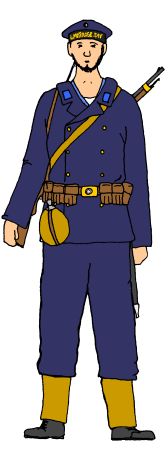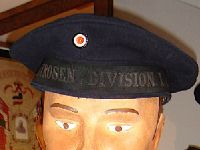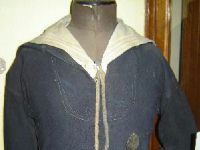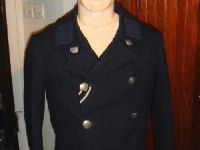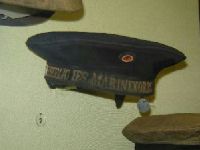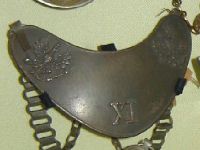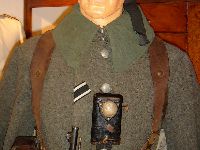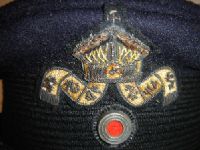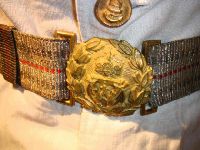| Figure 2 is based on a
wartime photograph of an Obermatrose from a Matrosen Division taken in
Flanders in 1916. A field grey naval top
was introduced by 1916 for the Matrosen Divisions and naval artillery
batteries. Although it had its own plain naval collar attached, it was
sometimes worn with the light blue collar over the top. It was also often
worn over the blue naval top or as in this case over a grey woollen
jumper. A single rank chevron in dark blue (as worn on the white
summer naval uniforms) displays this sailor's rank as Obermatrose (or
Sailor 1st class).
Naval caps were also issued in field grey.
They were of the same design as the previous blue caps with an imperial
cockade and black cap tally. In this case the sailor is wearing a
field grey band over the cap tally. This sailor carries his rifle with a
protective cover over the breech. As well as standard German army weapons,
the Matrosen Divisions were also armed with large stocks of captured
Russian Mosin-Nagant rifles. His M1909 equipment is in blackened leather
with a dull grey belt buckle to replace the original pre-war brass and
white metal pattern.
Most naval troops were confined to the far
Western coastal sector of the Western Front but a naval Pioneer company
also served on the Somme sector in 1916 in these same field grey naval
uniforms.
|
| |
| Figure 3 is based on a
wartime photograph of a Matrose from 1. Matrosen Division taken in
Flanders in 1918. The ubiquitous M1915 tunic began to be issued to the
Matrosen Divisions and Naval Batteries during 1917. The version for the
sailors units had no shoulder straps. This sailor also wears the field
grey naval cap with imperial cockade and black cap tally with "1. MATROSEN
DIVISION" in gold lettering. Slate grey trousers
came with the M1915 tunic and field grey puttees were commonly worn by
most frontline units by 1918. M1916 pattern steel helmets were also issued
to the Matrosen Divisions from 1917. |
| |
| Figure 4 is based on a
photograph of a Naval Gendarme from XI Armeekorps taken in
Flanders about 1918. As well as coastal artillery and frontline
duties, sailors served as military police. This naval gendarme wears a
blue naval cap with a field grey band over his cap tally (in the original
photograph the gendarme next to this man has a cap tally reading "SMS
Friedrich der Grosse"), the tails of
which can be seen on the collar of his field grey infantry greatcoat, worn
without shoulder straps or collar patches. He wears an M1915 field grey
infantry greatcoat (see below) without shoulder straps, underneath which
can be seen of his M1915 uniform as worn by the previous figure.
German military police were
distinguished by metal gorgets ("Brustschilder") worn at the throat
(see below left). Initially these were highly polished metal but later in the war they came to be made of dull metals or
painted field grey. This gorget has a Prussian eagle in each corner with a
personal number for each gendarme in Arabic numerals above the Army Corps
number in Roman Numerals, in this case the 11th Army Corps (or XI Armeekorps).
|
| |
|
|
| |
| Figure 5 is based on a
wartime photograph of Marine-Vizefeldwebel (Naval Senior Sergeant) and
Offiziers-Stellvertreter (Deputy Officer) Ramcke of the
Assault Troops of the 2nd Matrosen Regiment, 1st Matrosen Division
taken in Flanders in 1918. He wears an M1915 officers and senior NCOs uniform with
higher collar than that of the other ranks with NCO lace and collar button
to show his rank as Vizefeldwebel. The shoulder straps for a deputy
officer were uniform colour (in this case field grey) with lace edges and
a brass badge of an anchor with a rope twisted around it. The Iron Cross first class cross
is on his lower left breast, the second class is worn as a small ribbon on the upper
left breast. As with the field grey other ranks naval caps, officers
peaked naval caps were issued in field grey and worn with the same
insignia (in this case that of a deck officer- see above) and same black cap band as on their usual blue or white caps.
His belt is leather with a naval officers brass belt buckle (see above
right). He wears slate grey
trousers and short leather boots with gaiters. This officer wears nothing
to identify him as a member of the Assault or Strom troops but in action
the naval storm troops wore the same steel helmets, leather-patched
trousers, puttees and sand bags full of grenades as their army
counterparts. Bernhard Hermann Ramcke
(1889-1968) worked his way up through the ranks of all three armed forces,
from a lowly ship's boy to an air force general. He joined the Imperial
navy in 1905 as a Schiffsjunge, being made a Matrose in 1907 he served in
the 2nd Matrosen Regiment, 1st Matrosen Division. During the First Worls War he was promoted through NCO
ranks to Leutnant and served with distinction leading a storm-troop
platoon in the Marinekorps Flandern. After the war he served first as a
company commander in the Freikorps then as an officer in the
Reichswehr, being promoted up to Oberstleutnant before the Second World
War. In 1940 he transferred to the Fallschirmjäger (now part of the
Luftwaffe) and took part in the airborne invasion of Crete the following year. He and
his Fallschirm-Brigade-Ramcke then fought in the desert campaign in North
Africa at the battle of El Alamien and later in Russia. In 1944 he was
promoted to General and commanded the 2nd Fallschirmjäger Division in
Normandy, where he was captured by American forces at Brest. He was
released by the French authorities in 1951. (For a more detailed biography
see the
POW Camp 11 website) |
